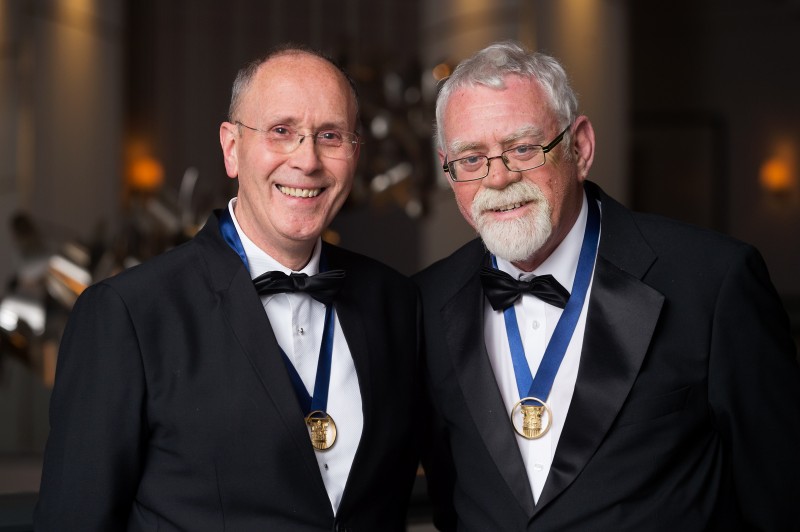
Tom Elder FRIAS and Dick Cannon FRIAS received the Lifetime Achievement Award at the annual RIAS Awards Dinner in Glasgow.
RIAS said the award is given “to those architects who, in the view of the Council of the RIAS, have made an outstanding contribution to architecture in Scotland”.
The Award was presented by RIAS President, Willie Watt, who said, “This Award recognises those whose life-long endeavour marks them out from their peers. This year, our centenary, it seems appropriate that two of the most remarkably consistent and most highly regarded of Scotland’s architects are both being honoured – it would be difficult to find two nicer or more talented individuals.”
The following citation for Richard Cannon and Thomas Elder was read out at the event:
“Tom Elder and Dick Cannon, as well as being two of the most profoundly decent human beings you could ever hope to meet, are also extraordinarily talented architects. The practice which bears their name, not only contributed many buildings of the highest quality to the architectural landscape of the West of Scotland, but has also helped to transform attitudes and approaches in urban design, public housing and education. Under new management it continues to do so.
Both Tom and Dick were born in 1943. Dick Cannon undertook his studies at the Duncan of Jordanstone School and Tom Elder studied on the part-time course at the Mackintosh School. They met when they were both apprentices at Wright and Kirkwood in the 1960s. They co-founded Elder and Cannon Architects in 1980.
Their first projects brought them immediately to public attention and architectural acclaim. The D&D warehouse, just south of the Clyde in Central Glasgow, the Church of the Holy Name in Mansewood and the National Bank of Pakistan at Sauchiehall Street were rigorous, distinctive and appropriate, all contemporary but each respecting its historic context. These attributes have continuously defined all of Elder and Cannon’s undertakings.
The practice’s first major mixed urban development was for the hugely innovative, architect-lead, developer Kantel. The reconfiguration of 14 buildings in Ingram Square, combined new-build, conversion and façade retention, to provide 240 flats and shops. More than any other development, this significant urban regeneration project kick-started the process of revitalising Glasgow’s Merchant City, a process which has subsequently spread both south and east, helping to generate a vibrant new community. While Ingram Square was careful in its scale and articulation to respect the immediate and wider historic contexts, it also made a number of radical moves, including the use of brick, which helped re-write the rule book for city centre projects in Glasgow. Elsewhere in the city and as far afield as Clydebank, Elder and Cannon’s contribution, for enlightened clients, was considerable and enduring.
For Reidvale and Gorbals, among other housing associations, Elder and Cannon produced a whole series of inspired projects, each one different and distinctive and each one influencing numerous developments which have followed. Their housing association clients demanded enhanced space standards and the highest quality for their tenants, a challenge to which Elder and Cannon responded very willingly, within the constraints of very rigorous budgets.
In their housing association work and also subsequently at the Homes for the Future development beside Glasgow Green, Elder and Cannon helped re-write the rule book for the contemporary tenement. In education too, Dick Cannon and Tom Elder have worked within the historic urban context to produce works for St Aloysius School in particular, but also elsewhere, which redefined the norm. The Junior School, The Clavius Building and subsequent work for St Aloysius have, undoubtedly, contributed to St Aloysius’ continuing extremely high standard and reflect the school’s forward-looking ethos.
The practice founded by Elder and Cannon has received over 70 awards. In 1991 it won the RSA Gold Medal for Architecture and in 2004 and 2009, the RIAS Andrew Doolan Best Building in Scotland Award. In 2007 it received the Lighthouse Achievement Award. Both Elder and Cannon have made notable contributions to tertiary education. The continuing success of the practice they nurtured, still run by long-term colleagues, is a further credit to their talents and the architectural ethos they established.
Writing in 2005, the architectural critic and educationalist, Penny Lewis, commented that “Elder and Cannon’s work is clever, they could even be described as the architect’s architect; their work exudes lateral moves and attention to detail.” She quotes Dick Cannon, who characteristically comments that architecture is a collaborative process, complementing the client, the whole design team and other specialists for everything the practice has achieved. In the same interview, with characteristic humour, when challenged as to why the practice’s work is a predominantly West of Scotland phenomenon, comments that this is due to “circumstances – and a lack of marketing!” It is a typically modest and self-deprecating comment which could have come from either Tom or Dick, emphasising as it does their humour, modesty and that shared quality of decency alluded to at the outset of this citation.
As architects, educators and innovators, Tom Elder and Dick Cannon have helped transform the West of Scotland and have fundamentally influenced architecture much further afield. They are quite rightly recognised by their peers as among the most talented and inspiring Scottish architects from the latter part of the last century and the beginning of this.”











